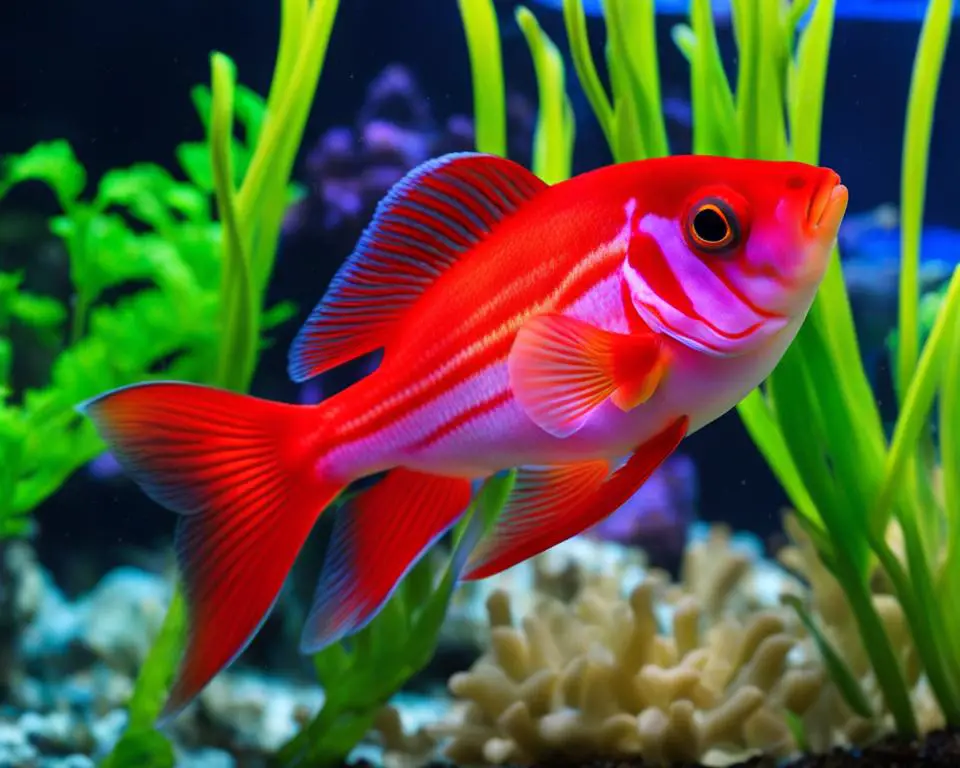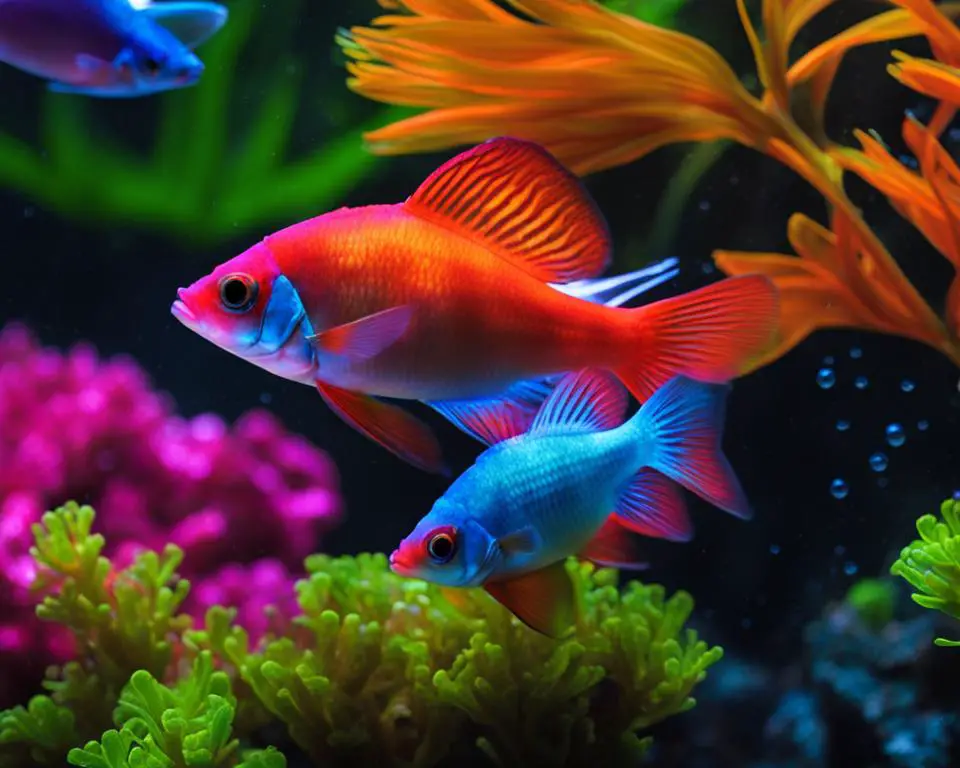If you’re a Glofish enthusiast or are considering adding them to your aquarium, you may be wondering about their behavior. One common question is, “Do Glofish chase each other?” In this section, we’ll explore Glofish behavior and social dynamics to answer that question and gain a comprehensive understanding of their behavior in aquariums.
Glofish are genetically modified fish that come in different colors. They are a vibrant addition to any aquarium, but it’s important to understand their natural instincts and behavior to provide an ideal environment for them to thrive.
Key Takeaways:
- Glofish behavior can be influenced by their natural instincts and the environment in the aquarium.
- Understanding their behavior can help provide a peaceful and harmonious tank.
- One common question is, “Do Glofish chase each other?”
- In this section, we’ll explore Glofish behavior and social dynamics to answer that question.
- Glofish are a vibrant addition to any aquarium, but it’s important to understand their behavior to provide them with the ideal environment to thrive.
Understanding Glofish Behavior in the Aquarium
Glofish are known for their strikingly vibrant colors and are a favorite among aquarium enthusiasts. However, like any fish, Glofish have their own set of behaviors and tendencies that are important to understand to ensure their well-being in captivity.
One behavior commonly observed in Glofish is aggression, particularly towards each other. While it is not uncommon for fish to display chasing behavior as a means of establishing dominance or courtship, it is important to monitor to prevent it from escalating into harmful aggression.
In addition to chasing behavior, Glofish may also display territorial behavior, especially towards their tankmates. It is essential to provide ample space and hiding spots for all fish in the aquarium to reduce the potential for conflict.
| Factors Affecting Glofish Aggression and Chasing Behavior | Impact on Glofish Behavior |
|---|---|
| Tank size | A smaller tank may exacerbate aggression due to limited space |
| Decoration | Too many decorations can create territorial disputes and limit swimming space |
| Presence of hiding spots | Providing ample hiding spots can reduce the potential for conflict and promote a sense of security for Glofish |
To reduce the likelihood of Glofish chasing their tankmates, it is important to provide a balanced and harmonious environment. Ensuring a proper diet and providing adequate space and hiding spots are key components to minimizing aggression and promoting peace in the aquarium.

“It is important for aquarium enthusiasts to monitor Glofish behavior closely to prevent harmful aggression.”
Do Glofish Chase Each Other in the Aquarium?
As mentioned in the previous section, Glofish are social creatures that exhibit complex behavior in the aquarium. When it comes to chasing, Glofish may engage in this activity both for dominance and courtship.
Male Glofish may chase females as part of the mating ritual. During this process, the male will display a vivid coloring to attract the female’s attention and then pursue her in an elaborate dance that involves chasing and courtship displays.
However, chasing behavior can also be a sign of aggression or territoriality. For example, in a tank with multiple Glofish, one fish may attempt to establish dominance through chasing and aggression to secure the best hiding spots or food sources.
It is important to closely observe your Glofish to determine the reason for their chasing behavior. If it is for mating purposes, it is perfectly natural and should not be a cause for concern. However, if it is due to aggression or territoriality, steps should be taken to resolve the issue.
Creating an environment with plenty of hiding spots and multiple feeding stations can help reduce chasing behavior. Additionally, having a tank that is large enough for the number of fish can also lower the levels of aggression and territoriality among Glofish.
In conclusion, Glofish do exhibit chasing behavior in the aquarium, but the reasons behind it can vary. By closely monitoring your Glofish and creating an ideal environment, you can help promote peaceful interactions and minimize any negative behavior.
Environmental Factors and Chasing Behavior
It’s important to understand how environmental factors can influence Glofish chasing behavior. This knowledge can help you create a peaceful and harmonious tank environment for your fish.
One key factor that can contribute to increased aggression and chasing behavior in Glofish is tank size. Overcrowding can lead to competition for resources and territoriality among Glofish. If you notice chasing behavior or aggression in your aquarium, consider upgrading to a larger tank to provide your fish with more space.
Another factor to consider is the presence of hiding spots and decorations. Having plenty of plants, caves, and other hiding places can help reduce stress among Glofish and minimize chasing behavior. These hiding spots can also help establish territories and provide a sense of security for your fish.
Additionally, the introduction of new tankmates can trigger chasing behavior in Glofish. It’s important to quarantine new fish before adding them to your aquarium to ensure they are healthy and won’t introduce any diseases to your tank. Slowly introducing new fish over a period of several weeks can help reduce the potential for aggression and chasing behavior.

Overall, creating a peaceful and harmonious tank environment is crucial to minimizing chasing behavior and promoting the well-being of your Glofish. By considering factors such as tank size, hiding places, and new tankmates, you can help ensure that your fish thrive in their aquatic home.
Conclusion
Based on our research, Glofish do exhibit chasing behavior towards each other in the aquarium. This behavior is typically seen among males in an effort to establish dominance or as a courtship display. However, chasing can also be a sign of aggression or territoriality, particularly if the tank is too small or lacks hiding spots.
To minimize chasing behavior and promote a peaceful environment, it is important to provide plenty of space and hiding spots for Glofish to explore and establish territories. A well-decorated tank with plenty of plants and decorations can also help to diffuse aggression and prevent chasing behavior.
In conclusion, while Glofish do chase each other in the aquarium, this behavior can be managed through proper tank setup and maintenance. By creating a harmonious environment with ample space and hiding spots, Glofish can peacefully coexist and provide a stunning display for any aquarium enthusiast.
FAQ
Do Glofish chase each other?
Yes, Glofish can exhibit chasing behavior towards each other. This behavior is often seen in situations where they are establishing dominance or engaging in courtship rituals. However, it’s important to note that not all Glofish will engage in chasing behavior, as individual personalities and environmental factors can influence their interactions.
Do Glofish chase their tankmates?
While Glofish may occasionally display chasing behavior towards their tankmates, it is not a common occurrence. In general, Glofish tend to have peaceful interactions with other fish in the aquarium. However, it’s always important to monitor their behavior and ensure that the tankmates are compatible to avoid any potential aggression or stress.
What causes Glofish aggression and chasing behavior?
Glofish aggression and chasing behavior can be influenced by various factors, including the size of the tank, the presence or absence of hiding spots and decorations, and the overall social dynamics within the aquarium. Lack of space and inadequate hiding places may increase the likelihood of chasing and aggression among Glofish. It is important to provide them with a well-structured and appropriately sized tank to minimize any aggressive behavior.
How can I prevent excessive chasing behavior among Glofish?
To minimize chasing behavior among Glofish, it is crucial to create an environment that promotes their natural behavior and reduces stress. Providing sufficient hiding spots, plants, and decorations in the aquarium can help create territories and break line of sight between Glofish, thus minimizing chasing behavior. Additionally, ensuring the tank is adequately spacious for the number of Glofish and maintaining compatible tankmates can also help prevent excessive chasing.
Can I keep multiple Glofish together without any chasing behavior?
It is possible to keep multiple Glofish together without any significant chasing behavior, especially when they are provided with a suitable tank environment and compatible tankmates. However, individual personalities and dynamics within the specific group of Glofish may still influence their interactions. Regular observation and monitoring of their behavior will help ensure a harmonious and peaceful tank for all Glofish.